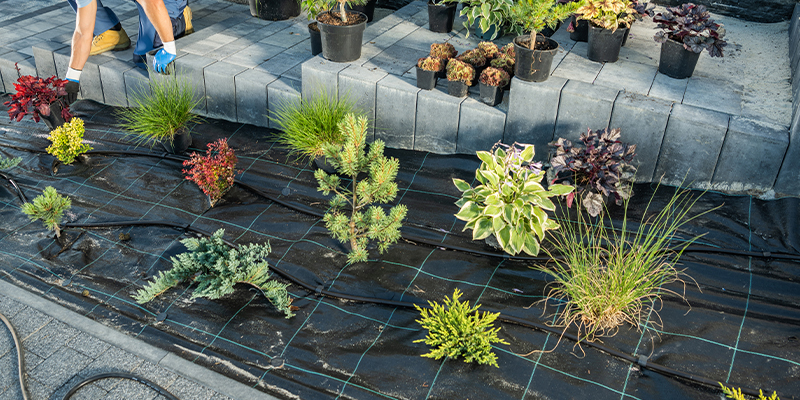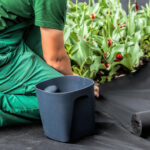What is Landscape Fabric?
Landscape fabric, also known as weed control fabric, is a breathable textile used extensively in gardens, nurseries and landscape projects. Its primary function is to prevent weeds from sprouting while letting air and water reach the soil, thus fostering a nurturing environment for plant growth.
This fabric is generally crafted from durable synthetic fibers such as polypropylene or polyester. These materials are chosen for their ability to endure various weather conditions and outdoor elements.
Such fabrics are integral in maintaining garden health, as they effectively block sunlight from reaching weed seeds, reducing their growth. At the same time, they help in preserving soil moisture, cutting down the need for regular watering. Additionally, the resilience of these fabrics means they can provide long-term weed control, often lasting several years with proper care.
Purpose Of Landscape Fabric
The purpose of landscape fabric is to control weeds and help maintain healthy soil. It acts as a barrier, stopping weeds from growing while still letting water, air, and nutrients reach the roots of your plants. By using landscape fabric, you can reduce the need for chemicals, keep your garden tidy, and protect your plants from competition with weeds.
Choosing the Right Landscape Fabric
When selecting the right landscape fabric for your garden, there are a few key factors to consider. The choice you make can significantly impact the health of your plants and the overall maintenance of your garden.
Consider Your Soil Type and Climate
- Different fabrics work better in different environments. Suppose you live in an area with heavy rainfall. In that case, you need a fabric that allows excellent water permeability to prevent waterlogging.
- For drier climates, look for fabrics that help retain moisture without causing overheating.
Intended Use
- If you’re using the fabric for high-traffic areas like walkways, opt for a heavier, more durable fabric.
- For flower beds or vegetable gardens, a lighter, more porous fabric is preferable to allow air and water to reach plant roots easily.
Pros and Cons of Different Fabrics
- Woven Landscape Fabric: Typically more durable and suitable for heavy-duty applications but less porous, which could affect soil moisture and airflow.
Tips for Purchasing Quality Landscape Fabric
- Look for UV-resistant fabric to ensure it doesn’t degrade quickly under sunlight.
- Check the fabric’s weight and thickness – thicker, heavier fabrics usually offer better weed control and durability.
- Read reviews and seek recommendations, especially from local gardeners or nurseries, as they will have experience with what works best in your area.
Remember, investing in the right landscape fabric can save you time and effort in garden maintenance in the long run. Feel free to ask for samples or additional information from suppliers to make the most informed decision for your gardening needs.
Preparation for Installation
Before laying down landscape fabric, proper preparation of the area is crucial. This initial step ensures that your fabric sits correctly and functions effectively. Here’s how to get your garden ready:
Clearing the Area
- Start by removing all weeds, debris, and stones from where you plan to lay the fabric. This creates a smooth surface and prevents sharp objects from puncturing the fabric.
- For the best results, trimming any overhanging plants or bushes is also a good idea.
Leveling the Ground
- Once the area is clear, level the ground. This doesn’t need to be perfect but aim for a generally flat surface to prevent water from pooling in certain areas.
- If there are dips or mounds, simply shovel soil from the higher areas into the lower ones until you achieve a more even surface.
Measuring the Area
- Measure the length and width of the area to determine how much landscape fabric you’ll need. It’s always better to have a little extra than to run short.
- Remember to account for any overlap between strips of fabric, typically around 3-6 inches, to prevent weeds from growing through the gaps.
Gathering Tools and Materials
- Ensure you have all the necessary tools and materials before you begin. You’ll need the landscape fabric, of course, along with garden pegs or staples to secure it to the ground.
- A good pair of scissors or a utility knife is essential for cutting the fabric to size.
- A trowel or garden spade will also be needed if you plan to plant through the fabric.
With these steps completed, you’re well on your way to a successful landscape fabric installation. Taking the time to prepare properly will pay off in the long run with a neater, more efficient weed control system.
How to Install Weed Block Fabric
Installing landscape fabric can be straightforward if you follow these simple steps. Here’s a guide to help you do it efficiently:
Laying Out the Fabric
- Start by unrolling the landscape fabric across the prepared area. Aim to cover the entire space, ensuring the fabric lies flat against the soil.
- It’s best to work in sections for larger areas, laying out one piece of fabric at a time.
Cutting and Fitting Around Plants or Obstacles
- If you have existing plants or obstacles like garden decorations, carefully cut an “X” or a hole in the fabric to fit around them.
- Make sure the cuts are just big enough for the plant stem or obstacle, keeping them snug to prevent weed growth around them.
Securing the Fabric
- Once the fabric is correctly positioned, it’s time to secure it. Use garden pegs or staples, placing them along the edges and at intervals of about 12-18 inches throughout the fabric.
- Ensure the pegs are firmly anchored into the soil to prevent the fabric from moving or getting blown away.
Overlapping Fabric Sheets
- If you need more than one sheet of fabric to cover the area, ensure that each piece overlaps the next by at least 3-6 inches. This overlap is crucial to prevent weeds from growing through the seams.
- Secure the overlapping areas with additional pegs or staples for extra stability.
Following these steps will ensure that your landscape fabric is installed effectively, providing a solid barrier against weeds while allowing your plants to thrive. Remember, taking your time during installation can save you a lot of effort in garden maintenance later on.

The Do’s of Installing Landscape Fabric
When installing landscape fabric, a few key practices can significantly affect its effectiveness. Here are some important ‘Do’s to keep in mind:
- Do Measure the Area Accurately: Precise measurement of your garden area is crucial. Underestimating can lead to insufficient coverage, while overestimating means wasted material. Use a tape measure to get the exact dimensions. Don’t forget to account for any irregular shapes or pathways within your garden.
- Do Overlap Seams: Overlapping seams are your best defense against weeds popping up through gaps. When laying out multiple fabric sheets, overlap them by at least 3-6 inches. This overlap creates a continuous barrier, enhancing the fabric’s effectiveness in weed control.
- Do Secure the Fabric Properly: Securing the fabric with landscape staples or pegs is vital to keep it in place. Insert the staples at the edges and intervals every 12-18 inches. In windy areas, you may need to place them more frequently. Ensure the staples are driven firmly into the ground for a secure hold.
- Do Consider Plant Placement: If you plan to add perennials, shrubs, or trees, consider their placement before laying the fabric. Mark spots where you plan to plant, and cut small X-shaped openings or circles for the plants. This allows for growth while maintaining the integrity of the weed barrier.
By following these tips, you can ensure a successful installation of your landscape fabric, leading to a healthier, more manageable garden. Remember, a little extra care during the installation process can save a lot of time and effort in garden maintenance.
The Don’ts of Installing Landscape Fabric
While knowing what to do is crucial, knowing what not to do can be just as important. Here are some key ‘Don’ts’ when it comes to installing landscape fabric:
- Don’t Skimp on Quality: Opting for low-quality landscape fabric might seem cost-effective initially, but it can lead to issues. Poor-quality fabric may tear easily, degrade quickly under sunlight, and might not effectively suppress weeds. Investing in a durable, high-quality fabric ensures long-term effectiveness. It saves you time and money in the long run.
- Don’t Leave Gaps: Even small gaps between the fabric sheets can become an entry point for weeds. This can defeat the entire purpose of installing the fabric. Ensure all seams are adequately overlapped and that there are no unsecured or loose ends where weeds can penetrate.
- Don’t Ignore the Edges: The perimeter of your landscape fabric is critical. If the edges are not properly secured, the fabric can come loose, allowing weeds to grow around the borders. Secure the edges with enough landscape staples or pegs, and consider tucking them under or covering them with border materials like stones or edging.
- Don’t Cover with Heavy Materials: While covering landscape fabric with a layer of mulch or gravel can improve aesthetics and further suppress weeds, be cautious about the weight. Excessively heavy materials can compress the fabric too much, affecting its permeability and the soil’s ability to breathe. Choose a top layer that’s protective yet light enough to maintain the fabric’s functionality.
By avoiding these common mistakes, you can ensure your landscape fabric installation is effective, durable, and beneficial for your garden. Remember, a little attention to detail can make a significant difference in the health and appearance of your outdoor space.
Common Mistakes to Avoid
When installing landscape fabric, a few common missteps can undermine its effectiveness. Being aware of these can help you avoid unnecessary problems in your garden:
- Overlapping Incorrectly Leading to Weed Growth: Proper overlapping of fabric sheets is essential. More overlap can leave room for weeds to sneak through. Ensure you overlap by at least 3-6 inches. This creates a continuous barrier that is much more effective at keeping those stubborn weeds at bay.
- Not Securing the Fabric Adequately: If the fabric isn’t anchored firmly, it can shift, creating gaps or exposing soil where weeds can flourish. Use enough landscape staples or pegs, especially around the edges and where fabric sheets overlap. You might need more pegs than usual in windy areas to keep the fabric in place.
- Choosing the Wrong Fabric Type for Your Garden: Different types of landscape fabric suit different garden needs. Using a heavy-duty fabric in a delicate flower bed or a too-light fabric in a high-traffic area can be counterproductive. Assess your garden’s specific needs—consider factors like plant types, soil condition, and foot traffic—before choosing your fabric.
You’ll be well on your way to a more effective and low-maintenance garden by steering clear of these common errors. Remember, the right start with landscape fabric can mean fewer headaches and more enjoyment in your gardening journey.
Aftercare and Maintenance
Once your landscape fabric is in place, a little bit of regular upkeep will go a long way in maintaining its effectiveness. Here are some key tips for aftercare and maintenance:
Regular Checks for Tears or Displacement
- Periodically inspect the fabric for any signs of wear and tear, such as rips or holes. These can happen over time due to environmental factors or garden activities.
- Check if the fabric has shifted or become uncovered, especially after heavy rains or winds, and re-secure it as needed.
Adding Plants or Making Changes Post-Installation
- If you add new plants to your garden, you can do so without disturbing the entire fabric. Carefully cut a small X or a circle into the fabric where you want to plant, fold back the flaps, and plant as usual.
- Make sure to close the flaps back around the base of the plant and secure the fabric again.
Long-Term Care Tips to Ensure Longevity of the Fabric
- Covering the landscape fabric with a layer of mulch enhances the garden’s appearance. It helps protect the fabric from UV rays, prolonging its life.
- Avoid using sharp tools directly on the fabric to prevent accidental damage. Be cautious around the fabric if you need to aerate the soil or perform other intensive garden work.
Following these aftercare and maintenance steps ensures that your landscape fabric continues to serve its purpose effectively for many years. A little attention to these details can make a big difference in the health and aesthetics of your garden.
In summary, installing landscape fabric can be a straightforward and rewarding task. It’s an effective way to control weeds, maintain soil moisture, and enhance the overall health of your garden. By measuring accurately, securing the fabric properly, and ensuring correct overlap, you set the stage for a thriving outdoor space. Regular maintenance, like checking for tears and adding new plants carefully, will extend the life of your landscape fabric.
Looking for quality landscape fabric? Anita Plastics offers a range of woven and non-woven landscape fabrics suited for various gardening needs. Visit our website to explore our products, or contact us for personalized advice and consultation. Let’s make your gardening journey easier and much more enjoyable!
Frequently Asked Questions (FAQs)
Can landscape fabric be reused?
Yes, high-quality landscape fabric can be reused, especially if it’s maintained well and still in good condition. Just ensure it’s free of tears and is still effective in suppressing weeds before reusing.
How does landscape fabric affect water drainage?
Good quality landscape fabric is designed to be permeable, allowing water to drain through while keeping the soil’s moisture balanced. However, choosing the right type of fabric for your soil type is important to ensure proper drainage.
Will landscape fabric work on all types of weeds?
Landscape fabric is very effective against most common weeds. However, additional weed control methods may be needed for more aggressive weed species, especially those with deep roots.
How long does landscape fabric last?
The lifespan of landscape fabric varies depending on the material quality and environmental conditions. Generally, it can last 5 to 20 years with proper installation and maintenance.
Is it necessary to cover landscape fabric with mulch or gravel?
While not strictly necessary, covering landscape fabric with mulch or gravel can enhance its effectiveness, protect it from UV rays, and improve the garden’s aesthetics.
Do you put weed barrier down before or after planting?
Weed barriers, such as landscape fabric or plastic, should be installed before planting. Here’s why:
- Prepare the Soil: Before laying down the weed barrier, clear the area of any existing weeds, rocks, or debris, and amend the soil as needed.
- Install the Weed Barrier: Lay the barrier over the prepared soil, making sure it fits snugly and covers the entire area. Secure it with landscape staples to prevent movement.
- Cut Holes for Plants: After installing the barrier, cut slits or holes where you want to plant, ensuring enough space for the plant to grow through the fabric.
By installing the weed barrier before planting, you create a solid foundation for long-term weed control without disturbing plants later.
How to Put Down Landscaping Fabric
To put down landscaping fabric, start by clearing the area of grass, weeds, and debris, ensuring the ground is flat. Measure the space and cut the fabric to size, allowing for some overlap if needed. Lay the fabric over the area, securing it in place with landscape pins or stakes every few feet. Finally, add a layer of mulch, rocks, or soil on top to hold the fabric down and prevent weeds from growing. Check regularly to ensure the fabric stays in place and that no weeds are emerging.
How to lay landscape fabric around existing plants?
Laying landscape fabric around existing plants helps control weeds and conserve moisture. Here’s a simple guide:
- Clear the Area: Remove any weeds, grass, or debris from around the plants.
- Measure and Cut Fabric: Measure the area you need to cover. Cut the landscape fabric to size, leaving extra to overlap the edges.
- Place the Fabric: Lay the fabric around the plants, making sure it covers the soil completely. Avoid putting fabric directly on the plant stems.
- Cut Slits for Plants: If necessary, make small cuts or slits in the fabric to fit around the plants. Gently tuck the fabric around the plant base.
- Secure the Fabric: Use landscape fabric stakes or pins to keep the fabric in place. Place them around the edges and through the fabric where needed.
- Cover the Fabric: Add mulch or gravel on top of the fabric to hold it down and improve its appearance.
How to lay weed barrier fabric?
To lay weed barrier fabric, clear the area of any weeds and rocks. Smooth the soil, then roll out the fabric over the ground. Overlap the edges by a few inches to cover the area well. Secure the fabric with garden staples or pins. If you’re planting, cut small holes in the fabric where needed. Finally, cover the fabric with mulch or stones to protect it and keep it in place.
How much landscape fabric do i need?
To determine how much landscape fabric you need:
- Measure the Area: Measure the length and width of the area you want to cover.
- Calculate the Total Area: Multiply the length by the width to find the total area in square feet or meters.
- Add Extra: Add a bit of extra fabric (about 6-12 inches) for overlap and adjustments.
For example, if you have a 10-foot by 5-foot area, you need 50 square feet of fabric. Adding extra, you might buy 55-60 square feet to be safe.
This ensures you have enough fabric to cover the area completely and handle any adjustments.
How close to put landscape fabric around plants?
No, you don’t put soil directly on top of landscape fabric. Instead, cover the fabric with mulch, gravel, or decorative stones. Soil can cause the fabric to tear or degrade. Mulch or gravel protects the fabric, helps with weed control, and keeps the garden looking tidy.
Does Landscape Fabric Allow Water to Drain?
Yes, landscape fabric allows water to drain. It is designed to let water, air, and nutrients pass through while blocking weeds from growing. The fabric has tiny pores that make it permeable, so rainwater or irrigation can reach the soil below. This helps keep your plants healthy by maintaining proper moisture levels without water pooling on the surface. By allowing water to drain properly, landscape fabric helps prevent soil erosion and keeps your garden or yard looking neat and tidy.
is it safe to use landscape fabric in vegetable garden?
Yes, it’s safe to use landscape fabric in a vegetable garden. It helps control weeds without using chemicals. Just make sure to use high-quality, breathable fabric, so water and nutrients can reach the soil. Also, avoid placing it too close to plant stems to allow for healthy growth.
Should I Use Landscape Fabric Under Gravel?
Yes, you should use landscape fabric under gravel. It helps prevent weeds from growing through the gravel while allowing water to drain properly. By placing the fabric underneath, you create a barrier that stops weed seeds from reaching the soil. This reduces the need for chemical weed killers and keeps the gravel area low-maintenance.
The fabric also keeps the gravel in place by preventing it from sinking into the soil over time. This gives your pathway or patio a longer lifespan and helps with stability. It’s a simple, affordable way to protect your gravel area and keep it looking neat.




